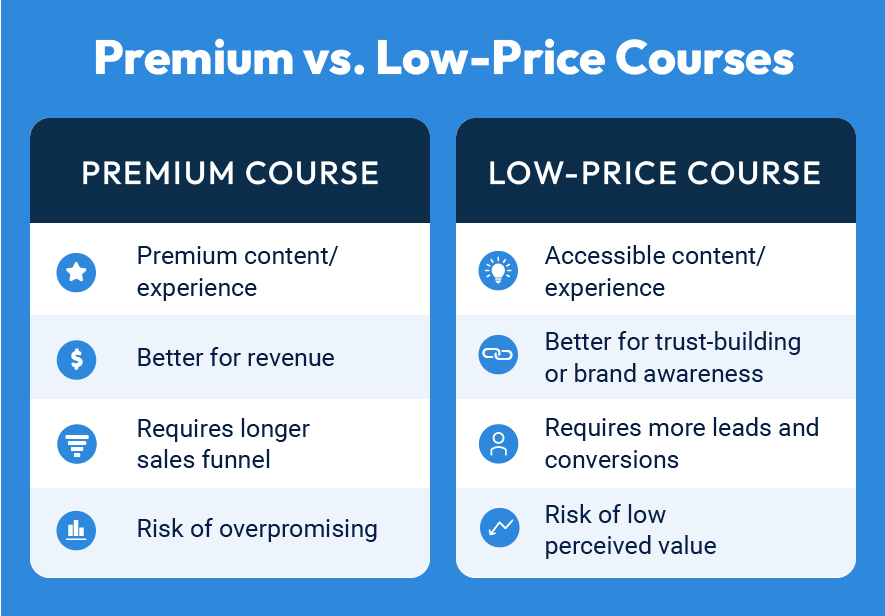You’ve landed on the perfect course topic, and it’s time to share your knowledge with the world. But how do you know what to charge for it? There is no one-size-fits-all answer to this question, but it comes down to four main considerations: the course’s value, purpose, costs, and structure. Once you factor in each of these elements, you’ll be able to set the right price for anything from mini-courses to masterclasses.
Step 1: Determine what kind of value it offers clients
The single biggest determining factor in the price of your course should be how much value itz delivers to your students. The value of your course might be estimable (like learning how to earn money from rental properties) — or maybe it’s intangible (like learning a new skill).
Here are some examples of the value that a course can deliver:
- Informational: students receive expert knowledge difficult to find elsewhere
- Monetary: students earn or save money as a direct result of course completion
- Experiential: students get access to a unique experience and/or online community
- Transformative: students’ lives are changed through successful completion of the course
The keys here are impact and exclusivity. The more significant the results — and the harder it is to get those results through any other means besides your course — the more your course is worth. It’s easy for online course creators to undersell their knowledge, especially the first time around. Factor in how much training and experience went into your product and consider what your course will accomplish in the lives of your students.
Step 2: Calculate revenue per enrollment rate
Before you get too deep into online course pricing strategies, revisit the original purpose and revenue goals behind your course idea. The sweet spot of course pricing is the number that reflects the value of the course to learners while achieving the course creator’s revenue goals.
A course that acts as a lead magnet would need to be priced (or given away) so that it attracts your ideal number of leads. It won’t necessarily make money on its own. But if you want to sell your course as a standalone digital product that drives passive income, it will need either a significant price point or a significant number of buyers (or both).
It’s important to know your ideal revenue goal so that you can adjust pricing and marketing strategies accordingly. Breaking down revenue goals into exact numbers will help you understand the concrete steps necessary for success.
Example: Revenue Goal of $10,000
Expected Conversion Rate: 10%
Option A: Sell the course for $100 to 100 customers (requires 1,000 leads)
Option B: Sell the course for $250 to 40 customers (requires 400 leads)
Option C: Sell the course for $1000 to 10 customers (requires 100 leads)
Step 3: Calculate your course expenses
The costs of producing and marketing your course easily build up without you realizing it – especially as you add more students and scale your business. Make sure you don’t get so busy delivering content that you fail to revisit the numbers! Set aside time to re-evaluate course costs and ensure your business is operating on the correct premises.
Course Creation Costs
Developing a course involves a variety of expenses – from the video equipment you use for filming lectures to the software that lets you upload, edit, and publish content. Expenses related to working with third-party vendors such as website designers or video editors also fall under the cost of course creation. As your course offerings grow, these expenses will likely increase.
Course Delivery Costs
Getting your course into the hands of students creates its own category of expenses. Shipping costs for course materials, membership management software, email automation software, and other aspects of course delivery quickly add up! Take inventory of each step you take to publish course content and itemize the costs involved.
Customer Acquisition Cost (CAC)
Your customer acquisition cost (CAC) is the average expense you incur to convert a potential student into a paying member. If you haven’t sold your first online course yet, you will need to make educated guesses about your budget and then adjust the numbers as you gather data.
Customer acquisition costs include all sales and marketing expenses such as advertising, discounts, or sales tools. Comparing your customer acquisition cost (CAC) to the customer lifetime value (LTV) helps you understand the profit you get from each new client based on your current methods for obtaining clients. (Customer lifetime value is the revenue you receive from someone over the whole length of time they are an active customer.)
Step 4: Choose a pricing model
The pricing model is how you package and deliver your online course. Can students buy the course for a one-time fee? Do they pay for an ongoing subscription or membership? Can they choose between various packages? There are a wide variety of models to choose from that include:
- Fixed Price — sell course materials for a convenient, one-time fee
- Subscription — charge a recurring fee for ongoing education
- Membership — give students an exclusive learning experience, not just a product
- Pricing Tiers — provide multiple course options with different price points
- Build-Your-Own — let students customize their course experience
- Freemium — introduce prospects to your brand with a free course
Consider your target audience and their needs, as well as your level of ongoing involvement and income goals. For example, a fixed price model is a simple option for evergreen content — but it runs on one-time purchases. You’ll have to consistently generate new leads to keep making money. Offering a membership or subscription is a great way to create a consistent income stream, but you’ll have to regularly release new material to make it worth your students’ investment.
Premium vs. Low-Price Courses
If you’re worried about sales, it’s easy to fall back on the idea that lower prices will attract more customers. While this can be true in some situations, many consumers actually associate higher prices with higher value and would rather pay more for a better product. However, that high price can backfire if students don’t feel they received a premium experience.
Ultimately, people want to believe that a product or service is worth their money. Overpricing and underpricing both discourage sales in different ways — one by overpromising and the other by underselling.

Charging a premium price:
Does your course offer high-value content?
The most fundamental rule for charging a high price is to offer premium content and/or a premium experience that is worth a premium price tag. This might seem like an obvious point, but it’s common for content creators to shy away from a higher price point because of doubt or to charge an unnecessarily high price for the sake of brand perception. Both can actually do damage to your brand’s reputation (although it’s better to start lower and gradually increase the price, than the opposite).
As you receive feedback or get new ideas, digital products are simple to improve. Here are a few examples of ways you can increase the value of your course:
- Upsell/cross-sell other products and services to past and current students
- Build a community (e.g. through a Facebook group, forum, or in-person events)
- Offer Q&A sessions, one-on-one coaching, or group coaching sessions
- Create a sense of urgency with limited-time offers or limited-space events
Does the price tag fit your target demographic’s spending range?
You might be geared up to offer a high-quality, high-cost course that you feel is worth it for your students — but will they feel the same way? Deep dive into your ideal client profile and make sure their income level and commitment level align well with the price you chose. “High price” means something different for every audience and every topic.
Are you prepared to build out a full sales funnel to convert?
Higher-priced courses should be marketed differently than low-cost courses. A client needs more trust and commitment to invest in an expensive course. Before you attach a high price tag to your new course, make sure you have a plan for nurturing leads over a long sales cycle.
Set up a persuasive sales page with testimonials, automated email sequences, and anything else your audience might need to make a purchase decision. Pay particular attention to the quality of your leads and not just the quantity. For a premium course to drive revenue, you need to find the perfect clients for your program and then be willing to invest heavily in their journey!
Payment options for premium courses
A premium course doesn’t have to be sold to one individual for one upfront payment (although this is certainly an option). Consider offering payment plans that let students pay in installments, or incentivizing businesses and organizations to pay for your course with group pricing deals.
Charging a low price:
A low price doesn’t guarantee more course sales. So why would you ever sell your course for less than you could? This strategy makes sense when the course has another purpose besides revenue generation.
Is the course a strategic building block in your business?
Revenue isn’t always the top goal for an online course. For example, a fitness coach could use a mini-course as a lead magnet that grows their email list, or a consultant could build trust in their services by offering a high-value course at a great deal. If you don’t need your course to be a big revenue driver, you can get more creative with its goals and pricing.
Does the price make sense to your target audience?
“Low price” and “high price” are relative terms that depend entirely on your target market and competition. Remember that what feels like an accessible or appealing price to you may not come across the same way to your audience. If you’re selling a course to C-Suite executives, for example, you might want to be careful how low you go. You want to convey that your course is worth their time! Make sure your audience research accounts for your students’ budgets and values.
Is a shorter lead-generating funnel a better fit for your course?
You may not need a long sales funnel for a low-cost, low-commitment course, but you will need a plan to make this digital product worth your effort. This typically means developing a strategy for consistent lead generation.
A high-ticket course needs fewer conversions to turn a profit from a specific client niche, but a course that’s designed for the purpose of building trust or drive sales for other products will need a high quantity of leads to make a difference. Your marketing strategy for a course like this should focus on generating a consistent stream of prospects and include a plan for how you will reach new audiences over time.
Kartra helps online course creators maximize sales
Kartra’s all in one online course platform makes it easy to create an outstanding experience for your students without piling on software subscription fees. As your online course business grows, there are a lot of tools you’ll need to market and manage your courses:
- Membership platform
- Email automation software
- Video and webinar hosting
- Landing page and form builder with templates
- Checkout software
…and the list goes on. Kartra offers all of these features and more — so you can deliver and manage your course from the same platform! Kartra’s full stack of native features will save you the time and costs of stitching together multiple platforms — creating a seamless experience for both you and your students.
Scale your online business with Kartra’s all in one platform for course creators.
Get started today


